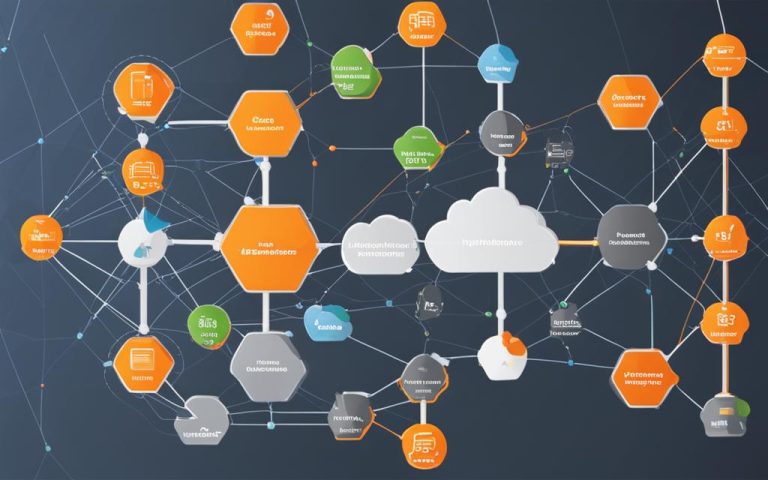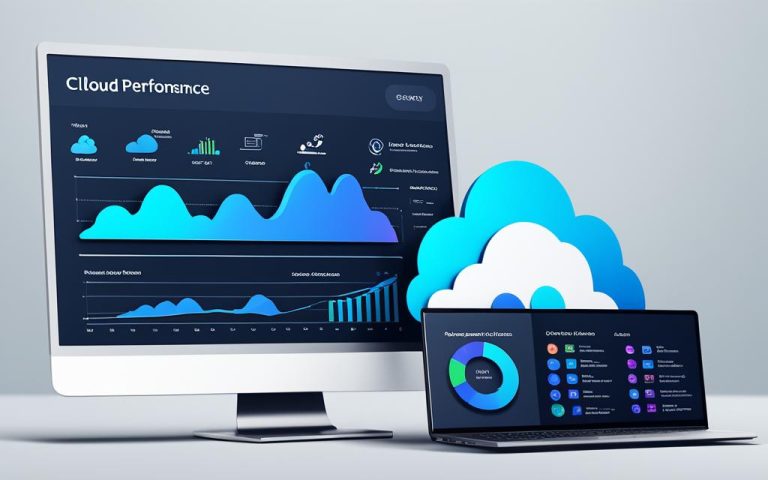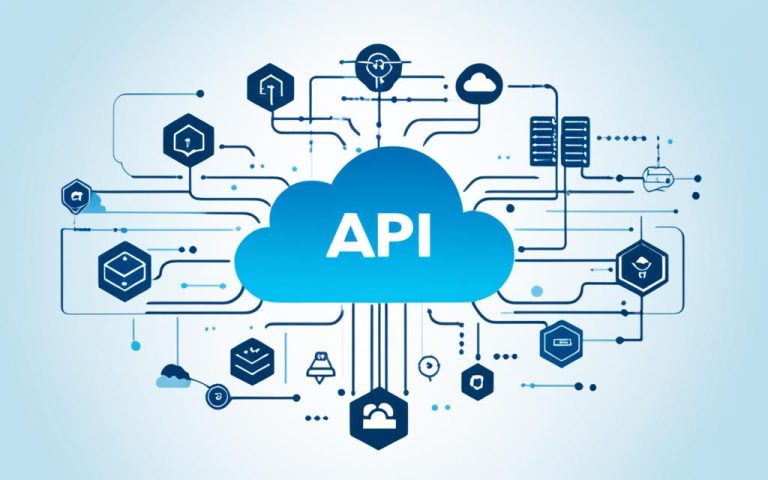Cloud computing has revolutionized the way organizations manage their IT infrastructure, offering a range of services such as infrastructure, platform, and software as a service. However, effectively managing the cloud can be challenging due to the vast array of available services and the lack of a standardized approach.
Enter cloud management tools – essential resources that enable organizations to efficiently deploy and orchestrate their cloud services. These tools provide a wide range of functionalities, including resource management, performance monitoring, scalability, automation and provisioning, cross-platform interoperability, compliance and governance, and reporting.
With the right combination of cloud management tools, organizations can streamline their operations, optimize performance, and ensure the success of their cloud-based initiatives.
Cloud Management Tools: Organizing and Steering Corporate Resources
Cloud management tools play a crucial role in efficiently organizing and steering corporate resources in the cloud. These tools provide organizations with the necessary control and deployment capabilities for cloud resources, resulting in reduced administrative overhead, accelerated deployments, and improved resource tracking through a configuration management database (CMDB).
One of the core functions of cloud management tools is resource management. These tools empower IT teams to exercise control over each resource, capturing essential configuration details and best practices through service blueprints. By having this level of control, organizations can maximize resource utilization and ensure consistency in resource configurations.
Performance monitoring is another vital feature offered by cloud management tools. It enables IT teams to continuously monitor resource usage, allowing them to detect and address any performance issues in a timely manner. Additionally, performance monitoring facilitates auto-scaling of resources based on demand, ensuring optimal resource allocation. By leveraging historical usage data, organizations can make informed predictions regarding resource capacity needs, enabling proactive planning and optimization.
Scalability is a critical aspect of cloud management tools. As organizations grow and adopt new technologies, these tools must be flexible enough to incorporate and support such advancements. Scalability also extends to the ability to manage resources across different geographical locations, enabling seamless global operations.
Automation and provisioning capabilities provided by cloud management tools streamline operational tasks and reduce reliance on manual intervention. This automation ensures efficient and consistent resource provisioning, deployment, and management, freeing up IT personnel to focus on more strategic initiatives.
Cross-platform interoperability is an essential feature that enables the consolidation of cloud systems management into a unified dashboard. It simplifies the complexity associated with managing multiple cloud environments and enhances overall efficiency.
Compliance and governance are critical considerations for organizations operating in the cloud. Cloud management tools offer features that facilitate authorized access, automate regulatory compliance, and ensure adherence to operational policies. These features play a pivotal role in maintaining data security and regulatory compliance, giving organizations peace of mind.
Reporting capabilities provided by cloud management tools offer valuable insights into the entire system. This includes comprehensive visibility into resource usage, system health, costs, and chargeback/showback information. Robust reporting assists organizations in making informed decisions, optimizing resource allocation, and managing costs effectively.
In summary, cloud management tools are indispensable for organizing and steering corporate resources in the cloud. From resource management to performance monitoring, scalability, automation, cross-platform interoperability, compliance, and reporting, these tools empower organizations to utilize cloud resources efficiently and effectively. By incorporating cloud management tools into their operations, organizations can unlock the full potential of the cloud while maintaining control, compliance, and cost-effectiveness.
Choosing the Right Cloud Management Tools: Factors to Consider
When it comes to choosing cloud management tools for your organization, there are several factors you need to consider. These factors will determine the effectiveness and suitability of the tools for your specific needs, enabling you to make an informed decision. Here are the key factors you should keep in mind:
- Resource Management: The selected cloud management tool should provide comprehensive control and tracking of your resources, allowing you to efficiently allocate and manage them.
- Performance Monitoring: Look for tools that offer real-time monitoring, auto-scaling capabilities, and accurate capacity predictions. These features are crucial for maintaining optimal system performance and ensuring efficient resource utilization.
- Scalability: Consider the scalability of the cloud management tool to accommodate your organization’s growth and the integration of new technologies as your needs evolve over time.
- Automation and Provisioning: Tools that support automation and provisioning processes can greatly enhance your agility in app development and deployment, enabling faster and more efficient workflows.
- Cross-Platform Interoperability: If your organization utilizes multiple cloud systems, ensure that the chosen tool offers seamless management and interoperability across various platforms. This will simplify the complexity of managing multiple environments and improve operational efficiency.
- Compliance and Governance: Security and regulatory compliance are critical considerations. Choose a tool that provides robust compliance and governance features to ensure data security, privacy, and adherence to industry regulations.
- Reporting: Look for tools that offer comprehensive reporting capabilities, providing valuable insights into resource usage, system health, and costs. These insights will empower you to make data-driven decisions and optimize your cloud resources effectively.
Considering these factors will help you select the right cloud management tools that align with your organization’s specific requirements and goals, ensuring efficient resource allocation, performance optimization, and compliance with industry regulations.

Image: Choosing the right cloud management tools is crucial for effective resource allocation and performance optimization.
Cloud Computing Tools: Enabling Cloud Access and Management
Cloud computing tools are essential for enabling cloud access and management, providing organizations with on-demand access to IT resources over the internet. These tools eliminate the need for physical data centers by offering infrastructure, software, and dependencies required to run applications and workloads in the cloud. By leveraging cloud computing tools, organizations can achieve scalability, cost-effectiveness, and flexibility without the hassle of purchasing, installing, operating, and upgrading hardware.
There are different forms of cloud computing tools based on the type of cloud service being utilized. These include Software-as-a-Service (SaaS), Infrastructure-as-a-Service (IaaS), and Platform-as-a-Service (PaaS). Each form offers unique benefits and functionalities to meet specific business needs.
Examples of popular cloud computing tools:
- DigitalOcean Monitoring and Uptime
- AWS CloudWatch
- Microsoft Azure Monitor
- Google Cloud Operations
- Datadog
- AppDynamics
- New Relic
- Prometheus
- Dynatrace
- PagerDuty
- Splunk
These tools provide organizations with the necessary capabilities to access cloud resources, manage workloads, monitor performance, and ensure the smooth operation of cloud environments.
Built-in Cloud Monitoring Tools: Monitoring within Cloud Platforms
Built-in cloud monitoring tools play a crucial role in monitoring cloud platforms. These tools provide native integration, optimal performance tracking, ease of use, and streamlined troubleshooting within specific cloud platforms.
“Built-in cloud monitoring tools streamline the process of monitoring cloud platforms, providing organizations with the necessary insights to ensure optimal performance and troubleshoot any issues that may arise. These tools are designed to seamlessly integrate with specific cloud platforms, offering a range of monitoring capabilities.”
Examples of built-in cloud monitoring tools include:
| Cloud Platform | Monitoring Tool |
|---|---|
| DigitalOcean | DigitalOcean Monitoring and Uptime |
| Amazon Web Services (AWS) | AWS CloudWatch |
| Microsoft Azure | Microsoft Azure Monitor |
| Google Cloud Platform | Google Cloud Operations (formerly Stackdriver) |
These platform-specific monitoring tools offer organizations the ability to closely monitor their cloud resources, track performance metrics, and identify potential issues or bottlenecks.
Designed specifically for each cloud platform, built-in monitoring tools provide organizations with:
- Native integration
- Optimal performance tracking
- Ease of use
- Streamlined troubleshooting
With these tools, organizations can effectively monitor their cloud platforms, identify and address performance issues, and ensure the smooth operation of their cloud-based services.
Streamlined Monitoring for Cloud Platforms
One of the key advantages of built-in monitoring tools is their seamless integration with cloud platforms. This integration allows organizations to leverage the full potential of the platform’s monitoring capabilities, reducing the complexity of managing multiple monitoring solutions.
For example, DigitalOcean users can take advantage of DigitalOcean Monitoring and Uptime tools, which provide real-time performance monitoring and uptime tracking within the DigitalOcean cloud platform itself. This eliminates the need for third-party monitoring solutions and ensures a streamlined monitoring experience.
Similarly, Amazon Web Services (AWS) offers AWS CloudWatch, a built-in monitoring service that provides comprehensive monitoring for AWS resources and applications. Organizations using AWS can leverage CloudWatch to gain insights into resource utilization, application performance, and operational health.
Microsoft Azure users can benefit from the native integration of Microsoft Azure Monitor. This built-in monitoring service offers a unified platform for collecting, analyzing, and acting on telemetry data from Azure resources. With Azure Monitor, organizations can gain visibility into the performance and health of their Azure-based applications and services.
Google Cloud Platform provides Google Cloud Operations (formerly Stackdriver) as its built-in monitoring tool. Google Cloud Operations offers robust monitoring and troubleshooting capabilities, allowing organizations to track resources, detect anomalies, and gain insights into the performance of their Google Cloud-based applications and infrastructure.
These built-in monitoring tools are designed to offer organizations seamless access to critical performance data within their respective cloud platforms, enabling efficient monitoring, troubleshooting, and optimization of cloud resources.
Third-Party Cloud Monitoring Tools: Versatile Monitoring Solutions
Third-party cloud monitoring tools offer versatile monitoring solutions that can span across various cloud platforms and environments. These tools provide a comprehensive view of multi-cloud or hybrid cloud infrastructures, offering extensive features, customization capabilities, and a holistic perspective on system performance.
| Tool | Description |
|---|---|
| Datadog | A comprehensive monitoring and analytics platform that integrates with various cloud platforms and services. It offers real-time visibility, alerting, and customizable dashboards. |
| AppDynamics | An application performance monitoring tool that provides end-to-end visibility into the performance of cloud-based applications. It offers deep code-level diagnostics and automatic baselining. |
| New Relic | A monitoring and observability platform that helps organizations gain real-time insights into the performance, availability, and reliability of their cloud environments. It offers application performance monitoring, infrastructure monitoring, and user experience monitoring. |
| Prometheus | An open-source monitoring system that collects metrics from various targets in real-time and stores them in a time-series database. It offers powerful querying and alerting capabilities. |
| Dynatrace | A full-stack monitoring platform that provides automatic and intelligent observability across cloud environments. It offers AI-driven analytics, anomaly detection, and root cause analysis. |
| PagerDuty | An incident management platform that helps organizations respond to issues and incidents in real-time. It offers customizable alerting, on-call scheduling, and automated escalation. |
| Splunk | A log management and analytics platform that helps organizations collect, analyze, and visualize machine-generated data from various sources. It offers real-time searching, monitoring, and alerting. |
These tools offer comprehensive monitoring, integration and compatibility with various cloud platforms, scalability and flexibility, alerting and reporting features, user-friendly interfaces, security capabilities, cost management capabilities, customer support, and active user communities.
Conclusion
Effective management of cloud services is paramount for organizations seeking to maximize performance and efficiency. Cloud management tools play a pivotal role in organizing and directing corporate resources within the cloud, offering a range of essential features. These include resource management, performance monitoring, scalability, automation and provisioning, cross-platform interoperability, compliance and governance, and reporting. As organizations navigate the vast landscape of cloud management tools, careful consideration must be given to factors such as resource control, performance monitoring, scalability, automation, cross-platform compatibility, compliance, and reporting.
Organizations can leverage the built-in cloud monitoring tools provided by platforms like DigitalOcean, AWS, Microsoft Azure, and Google Cloud, which seamlessly integrate within their respective environments and facilitate accurate performance tracking. Additionally, third-party cloud monitoring tools offer versatility and a comprehensive view of multi-cloud or hybrid cloud environments, allowing organizations to assess system performance holistically. By combining the right cloud management and monitoring tools, organizations can effectively navigate the complexities of cloud service management, facilitating enhanced performance and streamlined operations.
To achieve successful cloud service management, organizations must prioritize the selection of appropriate tools that align with their unique needs and requirements. By considering factors such as resource management, performance monitoring, scalability, automation and provisioning, cross-platform interoperability, compliance and governance, and reporting, organizations can identify the cloud management tools that best suit their goals. Ultimately, investing in the right combination of cloud management and monitoring tools is the key to unlocking the full potential of cloud services, empowering organizations to drive innovation and achieve operational excellence.
FAQ
What are cloud management tools?
Cloud management tools are software solutions that enable organizations to manage their multi-cloud resources and services. These tools provide functionalities such as resource management, performance monitoring, scalability, automation and provisioning, cross-platform interoperability, compliance and governance, and reporting.
Why are cloud management tools important?
Cloud management tools are important because they allow organizations to effectively deploy and orchestrate cloud services. These tools help organizations control and deploy cloud resources, reduce administrative overhead, accelerate deployments, and track all cloud components in a configuration management database (CMDB).
What factors should organizations consider when choosing cloud management tools?
Organizations should consider factors such as resource management capabilities, performance monitoring functionalities, scalability, automation and provisioning features, cross-platform interoperability, compliance and governance capabilities, and reporting tools when choosing cloud management tools.
What are cloud computing tools?
Cloud computing tools are software solutions that enable organizations to access IT resources on-demand, over the internet, and on a pay-per-use basis. These tools provide the infrastructure, software, and dependencies required to run applications and workloads in the cloud.
What are built-in cloud monitoring tools?
Built-in cloud monitoring tools are integral to monitoring specific cloud platforms. These tools offer native integration, optimal performance tracking, ease of use, and streamlined troubleshooting within the respective cloud platforms.
What are third-party cloud monitoring tools?
Third-party cloud monitoring tools provide versatile monitoring solutions that can span across various cloud platforms and environments. These tools offer a comprehensive view of multi-cloud or hybrid cloud infrastructures, extensive features, customization capabilities, and a holistic perspective on system performance.



















